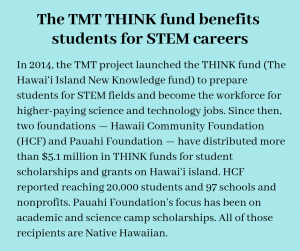Findings and conditions for the TMT to proceed
Posted on Aug 29, 2019 in Capitol Connection, FeaturedFrom its initial site selection in 2009 to the notice to proceed in July 2019, the Thirty Meter Telescope (TMT) on Mauna Kea has undergone unprecedented legal and community scrutiny. The process involved numerous public hearings, court appeals, and, finally, a 2018 Hawai‘i Supreme Court ruling that upheld a Conservation District Use Permit approved by the Board of Land and Natural Resources (BLNR).
After listening to stakeholders on all sides, TMT hearings officer and former Judge Riki May Amano issued a 305-page report in 2017 that included more than 40 conditions covering management, environmental, cultural, workforce and education concerns. These ranged from a “zero waste management” policy to mandatory cultural and natural resources training for employees and local STEM education funds, job training and hiring. Here is a summary of 
• Environmental protection – The TMT will not pollute groundwater, will not damage any historic sites, will not harm rare plants or animals, will not release toxic materials, and will not otherwise harm the environment.
• Cultural protection -The TMT site was not used for traditional and customary native Hawaiian practices conducted elsewhere on Mauna Kea, such as depositing piko, pilgrimages, or burials. The site is not on the summit ridge but rather 500 feet lower.
• Ceremonial practices – The TMT will not interfere with ceremonies or other spiritual practices. It cannot be seen from the actual summit and will not block views from the summit ridge of the rising sun, setting sun, or Haleakalā.
• Support for both Hawaiian culture and science – While some witnesses wanted more protection for Mauna Kea, others, including some Native Hawaiians, see TMT as a project that honors the mountain rather than injures it. They believe respect for Mauna Kea can be reconciled with modern astronomy.
• Support for education, conservation – TMT will contribute $1 million a year for STEM education and has a sublease agreement committing $300,000/yr. at first, increasing to $1 million/yr. for Mauna Kea conservation.
• Support for the local community and respect for cultural practices – Astronomy directly supports about 1,000 jobs in Hawai’i. TMT will employ about 140 people. The conditions in the report are meant to ensure that the project lives up to its environmental commitments, that the educational fund will help the underserved members of the community, that TMT will train and hire local workers, and that the Native Hawaiian cultural presence at Hale Pohaku will be enhanced.
